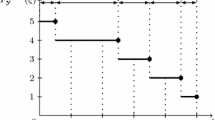Abstract
In large scale location-allocation studies it is necessary to use data-aggregation in order to obtain solvable models. A detailed analysis is given of the errors induced by this aggregation in the evaluation of thep-median objective function. Then it is studied how to choose the points at which to aggregate given groups of demand points so as to minimise this aggregation error. Forp-median problems with euclidean distances, arguments are given in favour of the centre of gravity of the groups. These arguments turn out to be much stronger for rectangular distance. Aggregating at the centroid also leads to much higher precision bounds on the errors for rectangular distance. Some numerical results are obtained validating the theoretical developments.
Similar content being viewed by others
References
Arora S., Raghavan P. and Rao S. (1998). Approximation schemes for Euclidean andk-medians and related problems. STOC98, 106–113.
Bongartz I., Calamai P.H. and Conn A.R. (1994). A projection method for ℓ p -norm location-allocation problems.Mathematical Programming 66, 283–312.
Bowerman R.L., Calamai P.H. and Brent Hall G. (1999). The demand partitioning method for reducing aggregation errors inp-median problems.Computers and Operations Research 26, 1097–1111.
Carrizosa E., Muñoz-Márquez M. and Puerto J. (1998a). Location and shape of a rectangular facility in ℝn, convexity properties.Mathematical Programming 83, 277–290.
Carrizosa E., Muñoz-Márquez M. and Puerto J. (1998b). The Weber problem with regional demand.European Journal of Operational Research 104, 358–365.
Casillas P.A. (1987). Data aggregation and thep-median problem in continuous space. In: Ghosh A. and Rushton G. (eds.),Spatial analysis and location-allocation models. Van Nostrand Reinhold Co, 327–344.
Cooper L. (1963). Location-allocation problems.Operations Research 11, 331–344.
Current J.R. and Schilling D.A. (1987). Elimination of source A and B errors inp-median location problems.Geographical Analysis 19, 95–110.
Drezner Z. (1986). Location of regional facilities.Naval Research Logistics Quarterly 32, 209–224.
Drezner Z. (1995). Replacing discrete demand with continuous demand. In: Drezner Z. (ed.),Facility Location, A survey of applications and methods. Springer, 33–42.
Erkut E. and Bozkaya B. (1999). Analysis of aggregation errors for thep-median problem.Computers and Operations Research 26, 1075–1096.
Francis R.L. and Lowe T.J. (1992). On worst case aggregation analysis for network location problems.Annals of Operations Research 40, 229–246.
Francis R.L., Lowe T.J. and Rayco M.B. (1996). Row-column aggregation for rectilinear distancep-median problems.Transportation Science 30, 160–174.
Francis R.L. and White J.A. (1974).Facility layout and location, an analytical approach. Prentice-Hall.
Goodchild M.F. (1979). The aggregation problem in location-allocation.Geographical Analysis 11, 240–255.
Hansen P., Jaumard B. and Tuy H. (1995). Global optimisation in location. In: Drezner Z. (ed.),Facility Location, A survey of applications and methods. Springer, 43–68.
Hillsman E.L. and Rhoda R. (1978). Errors in measuring distances from populations to service centers.Annals of Regional Science 12, 74–88.
Hodgson M.J. and Neuman S. (1993). A GIS approach to eliminating source C aggregation error inp-median models.Location Science 1, 155–170.
Megiddo N. and Supowit K.J. (1984). On the complexity of some common geometric location problems.SIAM Journal on Computing 13, 182–196.
Muñoz-Márquez M. (1995). El problema de Weber regional (The regional Weber problem) (in Spanish). Ph.D. Thesis, Universidad de Sevilla, Spain.
Plastria F. (2000). New errorbounds in continuous minisum location for aggregation at the gravity center.Studies in Locational Analysis 14, 101–119.
Rosing K.E. (1992). An optimal method for solving the (generalized) multi-Weber problem.European Journal of Operational Research 58, 414–426.
Rosing K.E. and Hodgson M.J. (1996). A systematic classification of applications of location-allocation models.JORBEL 36, 77–108.
Suzuki A. and Okabe A. (1995). Using Voronoi diagrams. In: Drezner Z. (ed.),Facility Location, A survey of applications and methods. Springer, 103–118.
Weiszfeld E. (1936). Sur le point pour lequel la somme des distances den points donnés est minimum.Tohoku Mathematical Journal 43, 355–386.
Zhao P. and Batta R. (1999). Analysis of centroid aggregation for the Euclidean distancep-median problem.European Journal of Operational Research 113, 147–168.
Author information
Authors and Affiliations
Additional information
This research was partially done while the author was on visit at the Laboratoire d’Analyse Appliquée et Optimisation at the Université de Bourgogne, Dijon, France. Thanks to E. Carrizosa, B. Rayco and four anonymous referees for many thoughtful remarks.
Rights and permissions
About this article
Cite this article
Plastria, F. On the choice of aggregation points for continuousp-median problems: A case for the gravity centre. Top 9, 217–242 (2001). https://doi.org/10.1007/BF02579084
Received:
Accepted:
Issue Date:
DOI: https://doi.org/10.1007/BF02579084




